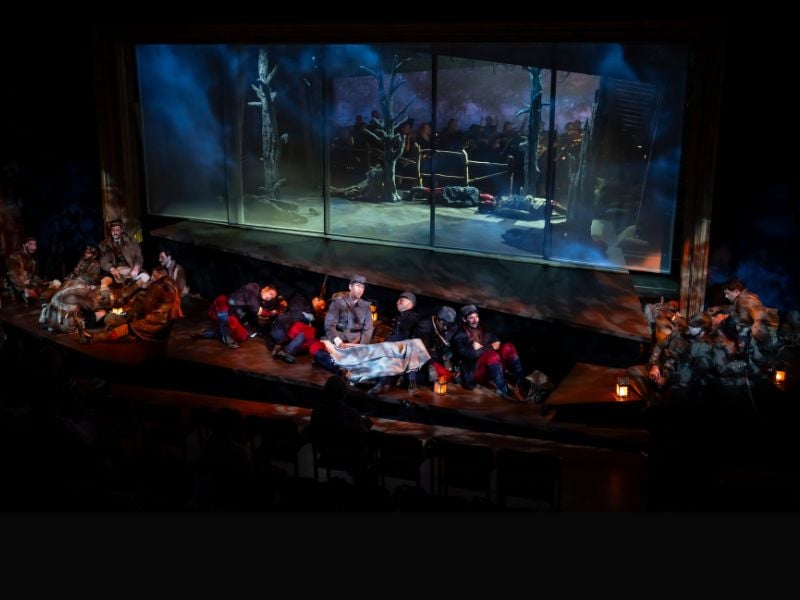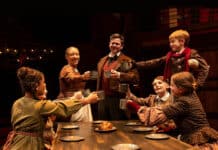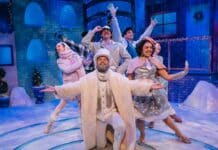The rains abated and the clouds parted for the opening of Silent Night at Wolf Trap. The opera by Composer Kevin Puts and Librettist Mark Campbell had been reimagined from previous major opera house productions to fit into the much smaller venue of The Barns. It was a good thing. It reframed the story of three armies meeting (Scottish, French, and German) on Christmas Eve in World War I and demonstrated conclusively trench warfare to be a cramped and messy business. Many of us in the audience felt we were in the trenches with them, and it brought the intertwining human stories into sharp focus. In experiencing the realities of a most un-glorious war, we become drawn into a truly glorious Puts-Campbell opera that sheds light on the power of art to uplift the human spirit in dangerous times.
Based on a historical event and a 2005 French screenplay, Joyeux Noel by Christian Carion, Campbell’s libretto of the 1914 Christmas truce focuses on a handful of characters who get caught up in a fight that upends their lives. In a brief prologue, an operatic performance is interrupted by the German declaration of war, and, shortly after, Anna, the Swedish star soprano (Keely Futterer), insists on following her singing partner and lover when he’s conscripted and must report to the battlefield. On the Scottish side, there’s William Dale (Kyle White), who, seeing the war as an opportunity for valor and adventure, talks his brother Jonathan (Martin Luther Clark) into enlisting with him — then William is killed early on, leaving Jonathan to mourn his brother and regret their enlistment. There’s French Lieutenant Audebert (Jacob Scharfman), who from the front writes a letter to his pregnant wife Madeleine (Tivoli Treloar), hoping fervently to see the birth of their child. There’s also Ponchel (Charles H. Eaton), aide de camp to Audebert, who injects much humanity and even humor into the proceedings by rhapsodizing over good coffee in true French fashion.

The famous event of the combatting armies declaring a truce Christmas Eve and singing to each other across the trenches in the dark has been turned into what appears to be a more than 24-hour bash. The Germans carry into the shared space miniature decorated Christmas trees; the French manage to scrounge up food and champagne; and the Scotts bring to the party whiskey they have just received in care packages. We get another wonderful duet from our opera singers, “Come Spring.” Even in war companionship and good times are snatched and show us our common humanity.
Co-directors Ryan and Tonya McKinny have made the most of this theme and bring out the importance of ordinary human activity, but especially song, to deepen the connection between war and art, and show us a nexus where perhaps the greatest human need can be met in the most meaningful way. The courage and boldness of their vision have made for a wonderful production.
It all started with the structuring of a marvelous libretto by Campbell, which moves the story forward in an emotionally satisfying way even while intertwining perspectives of multiple characters from three different worlds. The libretto is also commendably trilingual, and the opera is sung in the three languages of the nationalities represented.
Puts’ music is drop-dead gorgeous — sadly somewhat of a rarity in contemporary opera — from stirring military anthems (“The Glory of Battle”) to haunting melodies such as “Sleep” (“Alles ist stille”) sung by the entire male chorus. There is wonderful aria writing: show-off stuff for Soprano Miss Futterer, in which she excels, and heartrending pathos for Tenor Garcia, Baritone Jacob Scharfman, and others. Most importantly, he gets the loneliness, fear, and sheer exhaustion of war while managing to gift us with moments of joy and insist on the resilience of the human spirit. Conductor Geoffrey McDonald conducts the orchestra admirably, bringing both musicians and the worlds the opera represents together.

The young cast of singers is very fine, and this opera provides artists with good practice in singing in three of inherited opera’s “languages of choice.” (Well, maybe Scottish is pushing it.) All do admirably well with the different accents. It also allows the audience to receive many of the numbers in almost simultaneous translation without getting whiplash from resorting to the surtitles (a nasty aspect of being part of Team Opera).
The design team of Lawrence Moten (scenery), Lynly Saunders (costumes), Adam Larsen (video), and, in this case, the divine Colin K. Bills (whose lighting design just about knocked me out) have made some magic in this space. Moten maximized the use of the stage, dividing the stage proper into playing planes representing a No Man’s Land where the different sides meet, divided by a row of scorched trees (reminding me of the environmental “dead zones” of Paintball terrain), and crammed behind that the full orchestra positioned upstage. The other playing space, on a lowered apron of sorts extreme downstage, represented the different trenches, though it must be said this solution was perhaps less successful because of problematic sightlines beyond the first few rows.
Two other features are a far-upstage cyc onto which are projected historic newsreels among other images and downstage a screen that slides the full stage width where periodically mostly videos of close-up faces of the singer-actors appear. This allowed the audience to “zoom in” à la The Met’s HD performances and take advantage of “the best seat in the house.”
Silent Night resonates today as we think of countries such as Ukraine struggling on against Russian aggression. This opera can be viewed as a great anti-war piece. I would like it produced all over the country — and not just with professional companies but conservatories and universities. Silent Night deserves a place in the canon.
Running Time: Three hours with one intermission.
Silent Night plays again Thursday, August 15, 2024, 2 p.m, and Saturday, August 17, 7:30 p.m., presented by Wolf Trap Opera performing at The Barns at Wolf Trap, 1635 Trap Road, Vienna, VA. Tickets (sttarting at $45) can be purchased by calling 703-255-1800 or online.
The artistic and cast credits can be found here.



